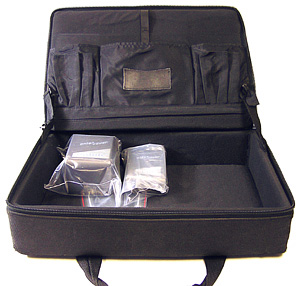New Li-ion Battery Travel Rules for 2009
SEATTLE At the dawn of 2008, a whole set of new air-travel regulations greeted videographers traveling with lithium-ion battery packs. (These regulations did not affect NiCad and most other popular videographer battery pack types.)
To welcome in 2009, this coming Jan. 1 will bring additional new regulations on lithium-ion batteries for videographers and other travelers. There is some tightening of restrictions, and some simplification in determining if you're following them or not.
BATTERY BUREAUCRACIES
There are two regulatory bodies that have jurisdiction over the transport of lithium-ion batteries in the United States—the United States Department of Transportation (DOT), which regulates domestic U.S. travel and air cargo, and the International Air Transport Association (IATA), which represents some 230 airlines that fly more than 90-percent of scheduled international air travel.

New rules covering the transportation of Li-ion batteries take effect Jan. 1. Last October, the U.S. DOT synchronized its lithium-ion rules with those of the IATA. On Jan. 1, 2009, the IATA rules will change. George Kerchner, executive director of the Portable Rechargeable Battery Association (PRBA), said he expects a proposed rule from DOT in the first four or five months of 2009 "to harmonize with international regulations." He said he expects a final U.S. rule to go into effect late in 2009.
Looking at the new IATA rules, as far as a videographer traveling with his camera equipment lithium-ion batteries is concerned, there are two important rule changes.
First, the process for identifying the capacity of a battery cell or battery pack has been simplified. Prior to these new rules, lithium-ion batteries were regulated based on their lithium equivalent content.
Since the battery industry and battery users were familiar with a battery rating in watt-hours, translating watt-hours to lithium equivalent content required some math: 8 grams of lithium-equivalent content equals 100 watt-hours. "Regulators thought [watt-hours] was a more realistic regulatory scheme as a way of regulating lithium-ion batteries," said Kerchner.
The second important change in regulation limits the maximum capacity of a lithium-ion battery being transported aboard a passenger airliner to 160 watt-hours, and requires the airline operator's permission to carry a lithium-ion battery with more than 100 watt-hour capacity.
And as with the prior rules, spare lithium-ion batteries can only be transported in carry-on luggage. The reasoning behind this rule is that a battery-caused fire breaking out in the cabin can quickly be extinguished by an aircraft crew-member, where such a fire breaking out in the cargo hold could potentially become much more serious before fire suppression equipment in that compartment kicks in.
"So if you have spare [lithium-ion] batteries, they have to be carried along in your carry-on luggage," said Kerchner. "Whenever they're placed in your baggage they have to be protected against short circuits. That can mean placing them in a plastic bag, or in the original packaging they came in."
KNOW YOUR SELLER
There are additional regulations for shipping such batteries as air-cargo, which are beyond the scope of this article other than to say that they must be shipped on non-passenger cargo planes and that there are strict packaging requirements.
Kerchner pointed out that a key safety measure that lithium-ion battery users can take is to make certain they are buying those batteries from reputable suppliers, and getting batteries made by original equipment manufacturers.
"All you have to do is search on the Internet for lithium-ion batteries and you'll find hundreds of manufacturers and vendors, but unless you're buying from an original equipment manufacturer or a company you've had dealings with over the years, [that 's] the primary way to know you're buying a quality battery product."
The major video and film equipment battery-pack suppliers have kept well abreast of these new major rule changes. They have developed products to fit these new regulations, battery types not affected by these regulations, and some of their Web sites offer helpful information about the new regulations.
Finally, it's fair to ask if these new regulations are a solution looking for a problem to solve. In the proposed rulemaking publication in the U.S. Federal Register last summer, the Pipeline and Hazardous Materials Safety Administration (which regulates battery shipment) and the Federal Aviation Administration (FAA) noted they "are aware of more than 90 incidents involving batteries or battery-powered devices in air transportation since 1996 that produced smoke, fire or a dangerous amount of heat."
While they said most of the incidents occurred or were discovered on the ground in air transport facilities or vehicles, "three incidents occurred in-flight on passenger and cargo planes, resulting in emergency landings or flight plan diversions." They noted that they believe many additional incidents were not reported.
Get the TV Tech Newsletter
The professional video industry's #1 source for news, trends and product and tech information. Sign up below.
